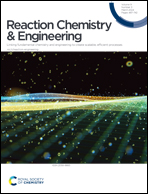Numerical and experimental evaluation of the hydrodynamics in a tubular swirling flow reactor and its comparison with the mixing regime of a stirred dark fermenter†
Abstract
This work aims to the computational fluid dynamics study and experimental evaluation of hydrodynamics and back-mixing of a homemade tubular swirling flow reactor intended to be used as an anaerobic dark fermenter (where an adequate mixing regime is needed to decrease H2 supersaturation in the system to enhance its production) and its comparison with a classical CSTR typically used for such process, considering a single phase. Simulation and experimental results on the CSTR reactor indicate that the mixing pattern relies on the reactor design and stirring conditions. Meanwhile, for the TSFR reactor, hydrodynamic conditions and inlet design are critical for the formation of swirl flow patterns and consequently for the improvement of mixing grade. Simulation studies show that the tangential inlet system proposed as a key design parameter provokes a distribution of velocity magnitude that favors the formation of vortexes inside of volume in both reactors. This study shows that the methodology carried out to compare the mixing performance of both reactors evidenced that the use of TSFR as a fermenter could represent a technological advantage since flow tubular reactors generally require a simpler design, cheap maintenance, and low energy requirements than the CSTR reactors.



 Please wait while we load your content...
Please wait while we load your content...